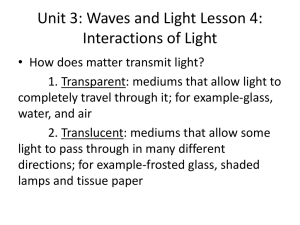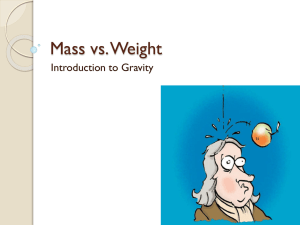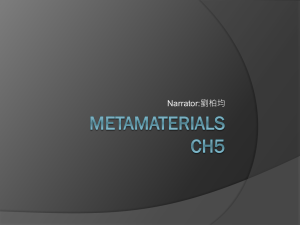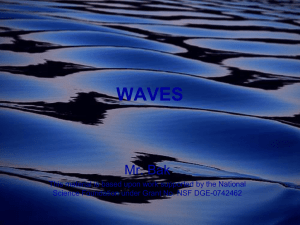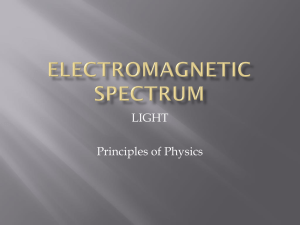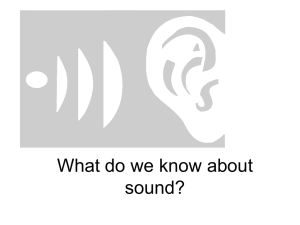Gravitational Waves: A new window to the universe
advertisement
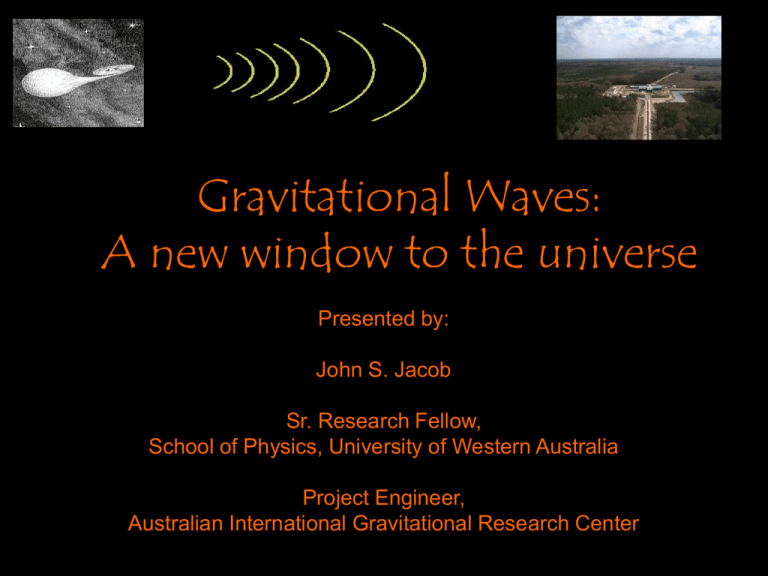
Gravitational Waves: A new window to the universe Presented by: John S. Jacob Sr. Research Fellow, School of Physics, University of Western Australia Project Engineer, Australian International Gravitational Research Center Gravitational Waves: A new window to the universe Acknowledgements ACIGA: Australian Consortium for Interferometric Gravitational Astronomy: David McClelland (ANU), Jesper Munch (U. Adelaide), Tony Lun (Monash). Gabriella Gonzales for some slides Prof. David Blair for some slides and inspired leadership of the center Dr. Ju Li for help with some slides All members of the UWA Gravity Waves Group LIGO Scientific Collaboration International Advisory Committee, High Optical Power Project The VIRGO Project, The TAMA Project and the GEO Collaboration Looking Out at the Universe Gamma Rays Bursts (BATSE) Infrared Microwave Background (COBE) These are all parts of the same Electromagnetic Spectrum. Gamma Rays Bursts (BATSE) Infrared Microwave Background (COBE) The Electromagnetic Spectrum? What’s That? In 1820, Hans Christian Oersted discovered that electric currents (moving electric charges) create magnetic fields. In 1831, Michael Farraday discovered that varying magnetic fields create electric currents. In 1864, James Clerk Maxwell put two and two together. • Oscillating electric fields create oscillating magnetic fields. • Oscillating magnetic fields create oscillating electric fields. • Together, electromagnetic waves propagate through empty space at a speed Maxwell calculated to be 3 x 108 meters per second. In 1886, Heinrich Hertz experimentally demonstrated creation and propagation of electromagnetic waves at the speed of light. It was eventually realized that: • Radio • Microwave • Infrared Light • Visible Light • Ultraviolet Light • X-Ray Radiation • Gamma Ray Radiation are all forms of Electromagnetic Waves. It was eventually realized that: • Radio – 100 km to 1 meter • Microwave – 10 cm to 1 mm • Infrared Light - 1/1000 mm • Visible Light – 500 micron • Ultraviolet Light – 100 nm to 10 nm • X-Ray Radiation - 10 nm to 0.01 nm • Gamma Ray Radiation – 0.01 nm to ?? are all forms of Electromagnetic Waves. In 1915, Albert Einstein presented his theory of General Relativity. • Matter changes the shape of space. • Space changes the path of matter. • Waves in the continuum of space can propagate forward at the speed of light. “Gravity waves.” Gravitational Waves: a different kind of waves They were predicted by Einstein: all moving masses change space time around them! Matter tells space how to curve. Space tells matter how to move. Not light waves!! But they also have different wavelengths… Gravitational waves: a new window GWs are produced by accelerated masses. They represent an entirely new spectrum. Gravity wave detectors are the ears that will allow us to listen to the sounds of the universe. Gravitational wave sources: • periodic sources: binary systems, • rotating stars… • burst sources: supernovae, collisions, black hole formations, gamma ray bursts?… • stochastic sources: clutter of signals from the entire universe, early moments of the big bang, cosmic strings?... But they are very weak…. We’ve been looking for them with detectors sensitive to changes in distance A BILLION TIMES smaller than an atomic diameter… and nothing yet!? Resonant bar detectors: University of Western Australia :NIOBE Lousiana State University (USA) ALLEGRO Astronomers are not surprised: most strong sources are VERY far away! Gravitational waves produce larger effects if the detectors are VERY long. We also want to try different wavelengths! What do we know about gravitational waves? That they exist!… Nobel Prize Physics 1993 Hulse & Taylor There is indirect evidence for the existence of Gravity Waves. Nobel Prize Physics 1993 Hulse & Taylor However, no one has yet been able to observe them directly. The ability to do so is important as a test of General Relativity and as a totally new kind of astronomy! Gravitational waves: an international dream Resonant Mass Detectors Gravitational waves: an international dream GEO600 (British-German) Hannover, Germany TAMA (Japan) Mitaka LIGO (USA) Hanford, WA and Livingston, LA AIGO (Australia), Wallingup Plain, 85km north of Perth VIRGO (French-Italian) Cascina, Italy Gravitational Waves: what else do we know? •Gravitational Waves are ripples in space-time. •They cause distortions of distances. •Their strength is measured by strain, the fractional change in distance, called h. Typical value of h is ~10-21. •The size of the waves is tiny because space is very “stiff”! •Because gravity only attracts - never repels, gravity waves have “quadrupole polarizations” pictured above. But how can we detect Gravity Waves? What measurable effect How to docould it? Gravity Waves have? What kind of instrument could directly observe them? Gravitational Waves: what else do we know? •Gravitational Waves are ripples in space-time. •They cause distortions of distances. •Their strength is measured by strain, the fractional change in distance, called h. •The size of the waves is tiny because space is very “stiff”! •A NS binary, oscillating at ~100 Hz, ~100 Mpc away, produces h~10-21 Simply measure the distance between two objects floating in space. If it’s that easy, why hasn’t it already been done? Problems: • The marks on the ruler would have to be a billion times smaller and closer together than the atoms the ruler is made of. • The objects might be drifting away from each other. We need a way to control them without constraining them too much. • The length of our ruler will also be affected by the gravity waves. Make the distance between controlled objects very large. The greater the distance, the greater the effect of gravity waves. Use a laser beam to measure the distance. For a change in distance due to gravity waves of 1 mm, the objects only have to be about one million billion kilometers apart. Problem: It would take more than one hundred years just to make one measurement. The distance must also be smaller than the wavelength we are trying to measure Solution: It’s much easier to measure differences between two large distances than it is to measure the large distances themselves. A device called an Interferometer does this with utterly ridiculous accuracy. An interferometer compares the distances traveled by two laser beams. It is sensitive to changes in length smaller than the wavelength of its light. Example of a simple Fabry—Perot Cavity Interferometer Fabry-Perot cavities Laser beamsplitter photo detector Are not both arms of the interferometer affected equally by gravity waves? Fabry-Perot cavities Laser beamsplitter photo detector Answer: Yes. However, due to the “quadrupole polarization” of gravity waves, the effects do not happen to both sides at the same time! Fabry-Perot cavities Laser beamsplitter photo detector By having its arms at right angles, an interferometer’s sensitivity to gravity waves is effectively doubled! Problem: Noise Many sources of “noise” reduce the sensitivity of an interferometer: • Laser fluctuations • Photon noise effects • Thermal vibrations of mirrors • Seismic noise Noise Solutions Laser Stabilization Frequency stabilization PBS Isolat or PC Laser Laser geometry fluctuation stabilization RF Oscillator T o laser interferometer PBS Mixer Reference Cavit y Mode cleaner—long optical cavity Photon Noise Effects: • Statistical sampling of photons: precision of the phase measurement increases as N1/2. • Radiation pressure of photons exerts random forces on mirrors, also increasing as N1/2. Solution: • Use an optimum number of photons. • Present detectors use 100 times too few photons. • Use a very powerful laser (100watts and build it up by resonance to 1 Megawatt). Problems with High Light Power • Powerful lasers cause Thermal Lensing. • The radiation pressure forces push the mirrors apart and create stability problems (before they cause photon noise.) Solutions: • Develop thermal lensing compensation techniques. • Develop better control systems. AIGO High Optical Power Test Facility Injection bench Injection locked 100W laser ACIGA - Pre-stabilisation cavity Beam expander 10m Mode cleaner Power recycling Detection bench Sapphire Input Mirror ACIGA arm 80m high power test cavity Sapphire end mirror Problems: • Seismic noise is a 1012 times stronger than gravity waves. • Ocean waves, people, cars and kangaroos! • AIGO site is 1000 times better than UWA. Full vibration isolation system thin fibre pendulum link simple wire pivot magnets copper Eddy current viscous coupling 2-d gimbal pivot concentric with wire pivot Eddy current damped rocker vertical Euler springs to next stage Self damped pendulum LIGO: Now testing, planning upgrade Estimated noise sources Australian International Gravitational Observatory AIGO (opened in 2000) and Wallingup Plain Gravity Discovery Centre SCCC: opened in 2001 Conclusion • AIGO is developing vital technology for the upgrade of detectors to reach a sensitivity where known sources are detectable. • It will be an essential element in the world array of detectors. • It offers opportunities to promote science for the benefit of all West Australians
